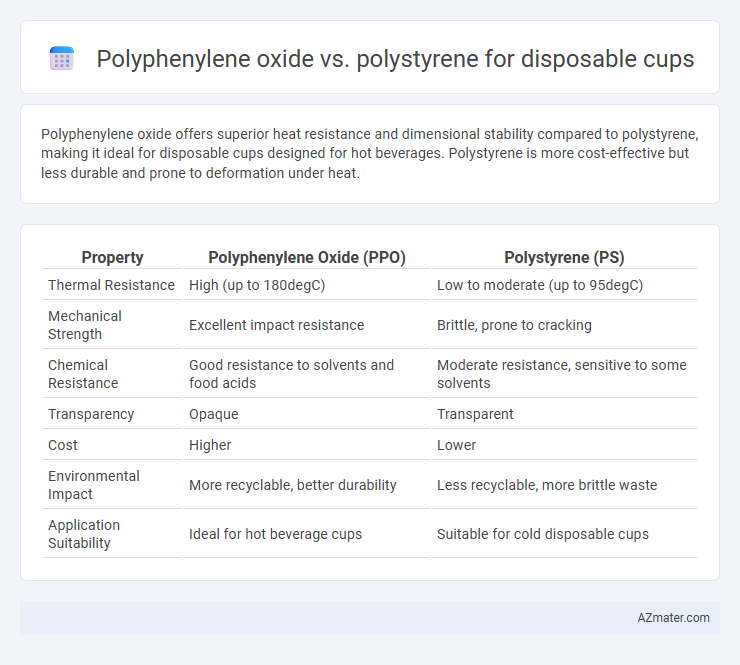Polyphenylene oxide offers superior heat resistance and dimensional stability compared to polystyrene, making it ideal for disposable cups designed for hot beverages. Polystyrene is more cost-effective but less durable and prone to deformation under heat.
Table of Comparison
| Property | Polyphenylene Oxide (PPO) | Polystyrene (PS) |
|---|---|---|
| Thermal Resistance | High (up to 180degC) | Low to moderate (up to 95degC) |
| Mechanical Strength | Excellent impact resistance | Brittle, prone to cracking |
| Chemical Resistance | Good resistance to solvents and food acids | Moderate resistance, sensitive to some solvents |
| Transparency | Opaque | Transparent |
| Cost | Higher | Lower |
| Environmental Impact | More recyclable, better durability | Less recyclable, more brittle waste |
| Application Suitability | Ideal for hot beverage cups | Suitable for cold disposable cups |
Overview of Polyphenylene Oxide and Polystyrene
Polyphenylene oxide (PPO) is an engineering thermoplastic known for its high heat resistance, excellent dimensional stability, and superior impact strength, making it suitable for reusable and high-temperature disposable cup applications. Polystyrene (PS), a widely used plastic for disposable cups, offers cost-effective manufacturing and clarity but has lower heat resistance and brittleness compared to PPO. The choice between PPO and polystyrene depends on factors such as desired thermal performance, mechanical durability, and production cost constraints.
Chemical Structure and Properties Comparison
Polyphenylene oxide (PPO) exhibits a rigid, aromatic backbone with oxygen atoms linking phenylene rings, offering superior thermal stability and dimensional integrity compared to the linear hydrocarbon chain structure of polystyrene (PS). PS, composed of repeating styrene monomers, presents lower thermal resistance and higher brittleness, making it less suitable for high-temperature applications such as hot beverage cups. The intrinsic differences in chemical structure result in PPO cups providing enhanced heat resistance, improved mechanical strength, and better chemical inertness compared to the more inexpensive but less durable polystyrene alternatives.
Thermal Stability and Heat Resistance
Polyphenylene oxide (PPO) offers superior thermal stability and heat resistance compared to polystyrene (PS), maintaining structural integrity at temperatures up to 260degC, whereas polystyrene typically deforms around 100degC. PPO's high glass transition temperature (~215degC) enables disposable cups to withstand hot beverages without warping or leaching, making it ideal for thermal applications. Polystyrene's lower heat distortion temperature results in limited use for hot liquids due to its tendency to soften and release styrene oligomers when exposed to elevated temperatures.
Mechanical Strength and Durability
Polyphenylene oxide (PPO) exhibits superior mechanical strength and durability compared to polystyrene (PS) when used for disposable cups. PPO offers higher impact resistance and dimensional stability under temperature variations, reducing the risk of cracking or deformation during use. Its enhanced thermal and chemical resistance ensures longer-lasting performance and greater reliability in demanding beverage applications.
Manufacturing Process Differences
Polyphenylene oxide (PPO) and polystyrene (PS) differ significantly in their manufacturing processes for disposable cups; PPO undergoes a more complex polymerization involving oxidative coupling of phenylene units, resulting in higher thermal stability and chemical resistance. Polystyrene is produced via simple free radical polymerization of styrene monomers, allowing faster and more cost-effective mass production but lower heat resistance. These differences influence processing techniques, with PPO requiring higher processing temperatures and careful handling to maintain its properties, while PS cups can be formed using conventional injection molding or thermoforming methods at lower temperatures.
Environmental Impact and Recyclability
Polyphenylene oxide (PPO) offers superior environmental benefits compared to traditional polystyrene (PS) in disposable cups due to its higher thermal stability and lower tendency to release harmful chemicals during degradation. PPO is more readily recyclable, enabling repeated processing without significant loss of material properties, which reduces landfill waste. In contrast, polystyrene cups are less environmentally friendly, as they break down into microplastics and are challenging to recycle effectively due to contamination and limited recycling infrastructure.
Cost Efficiency and Market Availability
Polyphenylene oxide (PPO) offers superior thermal stability and chemical resistance compared to polystyrene (PS), but it generally comes at a higher cost, limiting its cost efficiency for disposable cup production. Polystyrene dominates the market due to its low price, ease of manufacturing, and wide availability, making it the preferred choice for cost-sensitive applications. The widespread supply chain infrastructure and lower raw material expenses make polystyrene more economically viable for large-scale disposable cup manufacturing.
Safety and Food Contact Suitability
Polyphenylene oxide (PPO) offers superior thermal stability and chemical resistance compared to polystyrene, making it safer for hot beverages in disposable cups. PPO's FDA compliance for food contact materials ensures minimal leaching of harmful substances, enhancing overall food safety. Polystyrene, while cost-effective, poses risks of styrene migration and lower heat tolerance, limiting its suitability for hot liquids in disposable food packaging.
Application Performance in Disposable Cups
Polyphenylene oxide (PPO) offers superior thermal stability and higher impact resistance compared to polystyrene, making it ideal for disposable cups designed for hot beverages. Its excellent dimensional stability prevents deformation under heat, while polystyrene tends to soften and lose rigidity at elevated temperatures. PPO's enhanced chemical resistance also ensures no odor or taste transfer, improving user experience in disposable cup applications.
Future Trends and Material Innovations
Polyphenylene oxide (PPO) offers superior thermal stability and higher chemical resistance compared to polystyrene, making it a promising material for next-generation disposable cups. Advances in PPO copolymers and sustainable bio-based blends are driving innovation toward more environmentally friendly and durable single-use beverage containers. Emerging trends emphasize improved recyclability and enhanced barrier properties to extend product lifespan while minimizing plastic waste.

Infographic: Polyphenylene oxide vs Polystyrene for Disposable Cup
 azmater.com
azmater.com